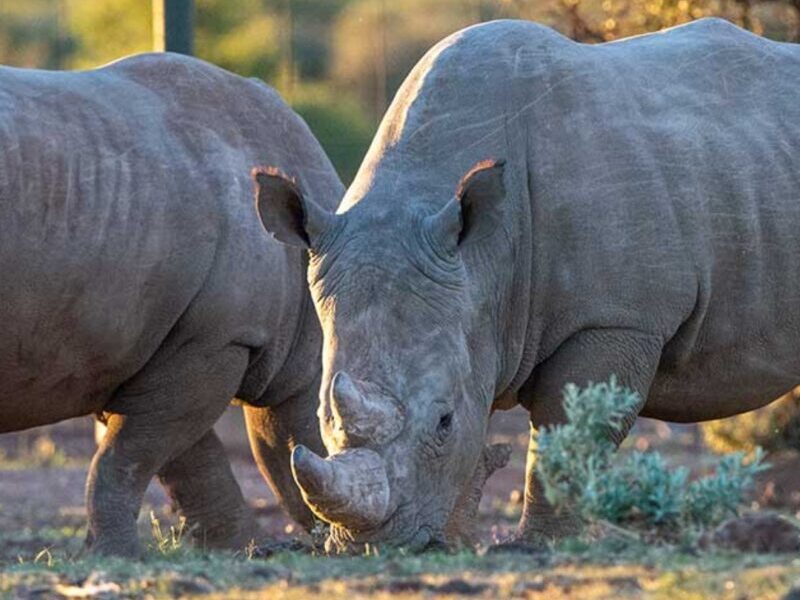In 10 Years the Rhino Population in SA’s National Parks Might Be Wiped Out
It’s a sobering thought: If you’re raising a child today, they might reach teenage hood and never get the chance to marvel at the sight of a rhino at Kruger National Park. Why? A recent annual report by SANParks shows that Kruger has lost an alarming 70 percent of its rhino population in the last decade. This is where private rhino conservations come in to play.
From a population of around 10 000 white rhinos and 600 black rhinos in 2010, the numbers are now down to approximately 3 549 white rhinos and 268 black rhinos. Overall in South Africa, 394 rhinos were poached in 2020, most of them in Kruger. If this trend continues, the entire rhino population currently protected by Kruger might be wiped out by 2030.
“From 10,000 rhinos in 2010 down to approximately 4,000”

TIME IS RUNNING OUT
The devastation of rhino poaching is no secret. But the SANPark report’s data gives grave insight into just how little time we have left before the poachers win the war. It also highlights an even deeper concern: our national parks like Kruger are simply not able to adequately protect rhinos – despite the millions of rands they receive from government and international donors in support of rhino conservation.
As rhino warriors ourselves, we know they’re up against a mammoth task. Protecting rhinos is hard, dangerous and expensive. Rangers put themselves in the line of fire every day, some of them suffering the same deadly fate as the animals they guard.
In addition, Kruger is roughly the size of Israel, making it difficult to police the entire area. It doesn’t help that poachers are lured with huge sums of money by corrupt individuals working with illegal trade syndicates.
But what happens when there are no rhinos left in the national parks?
The poachers won’t stop. They will simply turn their attention to the last surviving privately protected rhinos.
WHY PRIVATE RHINO CONSERVATIONS MIGHT BE THE LAST HOPE FOR THE SPECIES
“Over the last 30 or 40 years, the percentage of privately owned versus state-owned rhino conservations has shifted from one percent to 60 percent,” says Rockwood Conservation founder Wicus Diedericks.
Rockwood is one of the country’s approximately 330 private conservations. Together, these conservations hold 50 to 70 percent of the country’s entire rhino population.
“Private reserves hold 50 to 70 percent of the country’s entire rhino population.”
In contrast to national parks, private rhino conservations experience very few poachings. Only 37 of the 394 rhinos killed in South Africa in 2020 were on private rhino conservations. Rockwood, for one, has not had a single poaching incident in the last five years.
In addition, our conservation has celebrated the birth of more than 130 baby rhinos to date, with 10 newborns joining our family as recently as February 2021, taking our rhino population to more than 300. This means our rhino birth rate is much higher than the death rate, which is crucial in ensuring the survival of the species.
This alone is a triumph. But it’s even more significant when you consider that private rhino conservations receive no government funding and only limited donations.
So why are private rhino conservations having more success in rhino conservation than national parks? The private sector doesn’t like to lose where they’ve invested time, money and an endless amount of passion.

THE CHALLENGES FOR PRIVATE RHINO OWNERS
Private rhino conservations like Rockwood self-fund all the high-tech security, ranger costs, rhino feed, veterinary care and more needed to safeguard their animals. They hand rear baby rhinos whose moms can’t look after them. They also pour money into research and repopulation efforts, with the hope of one day relocating rhinos into the wild or, at least, to wild reserves and parks.
“I first bought rhino for the love of the animals, for the romance of it, and for them to roam free,” says Wicus, who turned Rockwood’s 33 000 acres of farmland into a rhino conservation in 2013.
“However, after the first poaching incident we had, I realised I had to protect them better. I was naive to think the rhinos could roam in the veld. I started to see that we are creating a safe and healthy environment for rhinos – but it comes with high price.”
“We are creating a safe and healthy environment for rhinos – but it comes with high price.”
The motivation for private owners is passion for conservation and uplifting local communities, but of course there also needs to be a way for them to earn income off their land. Owning rhinos needs to be sustainable because for private owners it’s all self-funded.
In the past, privately owned conservations like Rockwood were able to sell an adult rhino to another conservation for around R750 000, but these days the amount has dropped to around R100 000. “When you consider it costs approximately R500 000 to protect and nurture just one baby rhino from birth to breeding age, you start to understand the financial challenges we’re facing,” says Wicus.
As the rate of poaching increases, costs also increase as security methods need to improve. The situation for Rockwood has been exacerbated by severe drought conditions, which has meant trucking in tons of feed to supplement the natural grazing for rhinos. Over and above the financial costs, there’s an emotional toll on staff and their families as they constantly face the threat of ruthless poachers.
“At Rockwood, we are committed to our cause, but many other private owners have not been able to sustain their rhino conservation efforts for safety and financial reasons,” says Wicus.
The harsh reality is that private owners will begin to have no choice but to dispose of their animals. Considering the fact that private landowners now conserve more white rhinos than state owners, this would be a devastating blow to rhino conservation.
Self-funding of private rhino conservations can only take the species so far. How long before these private farms start to buckle under the burden of saving the species alone? Who will look after our rhinos then? The national parks?

